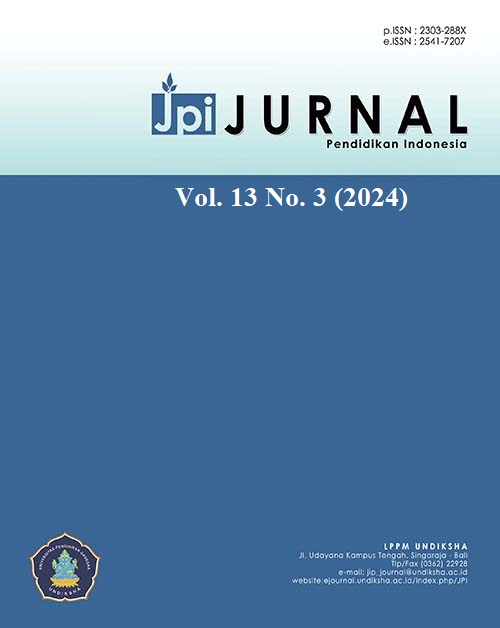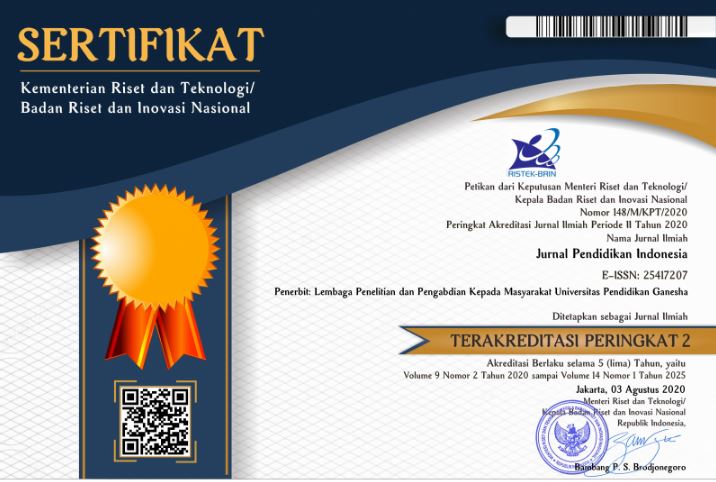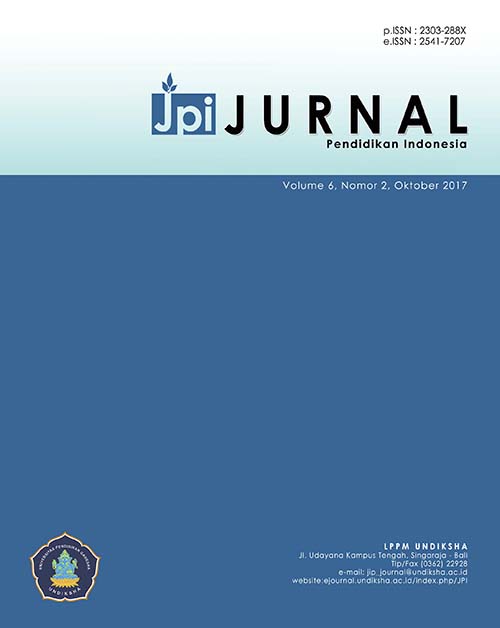Analisis Kemampuan Spasial Siswa Berdasarkan Gaya Kognitif Field Independence dan Field Dependence pada Materi Geometri
DOI:
https://doi.org/10.23887/jpiundiksha.v13i3.77083Kata Kunci:
Kemampuan Spasial, Gaya Kognitif, Field Independence, Field Dependence, GeometriAbstrak
Penelitian ini bertujuan untuk menganalisis kemampuan spasial siswa yang memiliki gaya kognitif Field Independence (FI) dan Field Dependence (FD) pada materi geometri dan mengetahui faktor penyebab terjadinya masalah pada kemampuan spasial siswa yang bergaya kognitif FI dan FD pada materi geometri. Jenis penelitian ini adalah penelitian kualitatif dengan pendekatan deskriptif. Teknik pemilihan subjek menggunakan purposive sampling. Subjek penelitian berjumlah 3 siswa FI dan 3 siswa FD kelas XII SMAN 8 Kota Jambi, dipilih melalui tes GEFT. Hasil penelitian ini menunjukkan bahwa kemampuan spasial siswa FI lebih baik dibandingkan siswa FD. Subjek FI yaitu SFI-1, SFI-2, dan SFI-3 mampu memenuhi semua indikator kemampuan spasial yaitu spatial perception, spatial visualization, mental rotation, spatial relation, dan spatial orientation. Sedangkan subjek FD yaitu SFD-1 hanya mampu memenuhi spatial visualization. SFD-2 dan SFD-3 belum mampu memenuhi seluruh indikator kemampuan spasial. Faktor penyebab terjadinya masalah pada kemampuan spasial siswa dialami oleh subjek FD yang berasal dari faktor internal yaitu mudah dipengaruhi/terkecoh, miskonsepsi, kurang memahami materi prasyarat, bergantung pada lingkungan, kurang teliti menuliskan jawaban, belum mampu mengilustrasikan gambar, serta merasa tidak yakin atas hasil jawaban. Dengan pemahaman yang lebih mendalam terhadap gaya kognitif dan faktor-faktor penyebab masalah, penelitian ini dapat memberikan kontribusi penting dalam pengembangan strategi pembelajaran yang lebih efektif dalam mengatasi kesulitan siswa dalam memahami materi geometri.
Referensi
Abdara, A. (2017). Analisis Kemampuan Calon Guru Matematika Dalam Pengajuan Masalah Ditinjau dari Gaya Kognitif Field Independent dan Field Dependent. Kreano, Jurnal Matematika Kreatif-Inovatif, 8(1), 69–75. https://doi.org/10.15294/kreano.v8i1.7120.
Aini, R. N., Murtianto, Y. H., & Prasetyowati, D. (2019). Profil Kemampuan Spasial Ditinjau dari Gaya Kognitif Reflektif pada Siswa Kelas VIII SMP. Imajiner: Jurnal Matematika Dan Pendidikan Matematika, 1(5), 90–96. https://doi.org/10.26877/imajiner.v1i5.4455.
Anwar, A., Takaendengan, B. R., Nirwana, L., & James, J. (2022). Analisis Kecerdasan Spasial Siswa dalam Menyelesaikan Soal-Soal Geometri Berdasarkan Tingkat Berpikir Van Hiele. Jurnal Pendidikan Matematika: Judika Education, 5(2), 116–125. https://doi.org/10.31539/judika.v5i2.4778.
As’ari, W., & Kusaeri, A. (2024). Analisis Kemampuan Spasial Siswa dalam Pembelajaran Matematika melalui Kendi Maling Banyumulek. Jurnal Basicedu, 8(2), 1474–1484. https://doi.org/10.31004/basicedu.v8i2.7427.
Astuti, P., Anwar, M. S., Choirudin, C., Juarlan, A. E., & Hagenimana, E. (2023). The Influence of Mathematical Logical Intelligence on Problem Solving Ability in Solving Story Problems. Delta-Phi: Jurnal Pendidikan Matematika, 1(1), 86–90. https://doi.org/10.61650/dpjpm.v1i1.43.
Busyairi, A., Harjono, A., Hikmawati, H., & Zuhdi, M. (2022). Comparative Analysis of Prospective Physics Teachers’ Learning Achievement in Terms of Cognitive Style (Field Dependent and Field Independent). Jurnal Pendidikan Fisika Dan Teknologi, 8(1), 42–47. https://doi.org/10.29303/jpft.v8i1.3505.
Cho, J. Y., & Suh, J. (2019). Understanding Spatial Ability in Interior Design Education: 2D-to-3D Visualization Proficiency as a Predictor of Design Performance. Journal of Interior Design, 44(3), 141–159. https://doi.org/10.1111/joid.12143.
Cho, J. Y., & Suh, J. (2022). The Architecture and Interior Design Domain–Specific Spatial Ability Test (AISAT): Its Validity and Reliability. Journal of Interior Design, 47(2), 11–30. https://doi.org/10.1111/joid.12211.
Darwina, D., Waspodo, M., Herawati, H., & Nurhayati, N. (2022). Requirements Analysis of Media Development Interactive Multimedia-Based Learning on Three Dimensional Geometry Materials. International Journal on Engineering, Science and Technology, 1(2), 113–122. https://doi.org/10.46328/ijonest.116.
Dilling, F., & Vogler, A. (2021). Fostering Spatial Ability Through Computer-Aided Design: a Case Study. Digital Experiences in Mathematics Education, 7(2), 323–336. https://doi.org/10.1007/s40751-021-00084-w.
Dunlosky, J., Rawson, K. A., Marsh, E. J., Nathan, M. J., & Willingham, D. T. (2013). Improving Students’ Learning With Effective Learning Techniques: Promising Directions From Cognitive and Educational Psychology. Psychological Science in the Public Interest, 14(1), 4–58. https://doi.org/10.1177/1529100612453266.
Ena, C., Prabawanto, S., Juandi, D., & Sugiarni, R. (2023). Spatial Ability In Middle School Mathematics Learning: Systematic Literature Review (Slr). Symmetry: Pasundan Journal of Research in Mathematics Learning and Education, 8(2), 277–287. https://doi.org/10.23969/symmetry.v8i2.7303.
Farmaki, C., Sakkalis, V., Loesche, F., & Nisiforou, E. A. (2019). Assessing Field Dependence–Independence Cognitive Abilities Through EEG-Based Bistable Perception Processing. Frontiers in Human Neuroscience, 13(October). https://doi.org/10.3389/fnhum.2019.00345.
Fishbach, A., & Woolley, K. (2022). The Structure of Intrinsic Motivation. Annual Review of Organizational Psychology and Organizational Behavior, 9, 339–363. https://doi.org/10.1146/annurev-orgpsych-012420-091122.
Galiakberova, A. A., & Galyamova, E. K. (2019). Cognitive Styles in Solving Educational Tasks. Journal of History Culture and Art Research, 8(4), 371. https://doi.org/10.7596/taksad.v8i4.2385.
Gonzales, R. A., Ferns, G., Vorstenbosch, M. A. T. M., & Smith, C. F. (2020). Does spatial awareness training affect anatomy learning in medical students? Anatomical Sciences Education, 13(6), 707–720. https://doi.org/10.1002/ase.1949.
Goswami, S., Das, A. K., & Nandy, S. C. (2021). Sparsity of weighted networks: Measures and applications. Information Sciences, 577, 557–578. https://doi.org/10.1016/j.ins.2021.06.090.
Gustanti, Y., & Ayu, M. (2021). The Correlation Between Cognitive Reading Strategies And Students’ English Proficiency Test Score. Journal of English Language Teaching and Learning, 2(2), 95–100. https://doi.org/10.33365/jeltl.v2i2.1452.
Hardi, N., Tambo, I. D., Fabelurin, O., & Khaminsou, B. (2023). Students’ Conceptions About Flat Side Space Materials Viewed From The Cognitive Styles of Students in Junior High School. Interval: Indonesian Journal of Mathematical Education, 1(1), 16–23. https://doi.org/10.37251/ijome.v1i1.610.
Izzatin, M., Waluyo, S. B., Rochmad, & Wardono. (2020). Students’ cognitive style in mathematical thinking process. Journal of Physics: Conference Series, 1613(1). https://doi.org/10.1088/1742-6596/1613/1/012055.
Jagom, Y. O., Uskono, I. V., & Leton, S. I. (2020). Students’ creative thinking in solving geometry problems. Journal of Physics: Conference Series, 1657(1). https://doi.org/10.1088/1742-6596/1657/1/012076.
Jawad, L. F. (2022). Mathematical connection skills and their relationship with productive thinking among secondary school students. Periodicals of Engineering and Natural Sciences, 10(1), 421–430. https://doi.org/10.21533/pen.v10i1.2667.
Jia, F., Wang, W., Yang, J., Li, T., Song, G., & Xu, Y. (2023). Effectiveness of Rectangular Cartogram for Conveying Quantitative Information: An Eye Tracking-Based Evaluation. ISPRS International Journal of Geo-Information, 12(2), 39. https://doi.org/10.3390/ijgi12020039.
Julaeha, S., Hidayat, T., & Rustaman, N. Y. (2020). Development of web-based three tier multiple choice test to measure student’s tree thinking; Try out. Journal of Physics: Conference Series, 1521(4). https://doi.org/10.1088/1742-6596/1521/4/042024.
Juman, Z. A. M. S., Mathavan, M., Ambegedara, A. S., & Udagedara, I. G. K. (2022). Difficulties in Learning Geometry Component in Mathematics and Active-Based Learning Methods to Overcome the Difficulties. Shanlax International Journal of Education, 10(2), 41–58. https://doi.org/10.34293/education.v10i2.4299.
Junita, N., Desnita, D., Asrizal, A., & Gusnedi, G. (2024). Analysis of the relationship between learning styles and creativity with high school Physics learning outcomes. ORBITA: Jurnal Pendidikan Dan Ilmu Fisika, 10(1), 43–51. https://doi.org/10.31764/orbita.v10i1.20063.
Khan, S. B. S., & Salman, R. (2020). Influence of mathematics in our daily lives. Arts & Humanities Open Access Journal, 4(2), 50–52. https://doi.org/10.15406/ahoaj.2020.04.00152.
Kozhevnikov, M., Evans, C., & Kosslyn, S. M. (2014). Cognitive style as environmentally sensitive individual differences in cognition: A modern synthesis and applications in education, business, and management. Psychological Science in the Public Interest, 15(1), 3–33. https://doi.org/10.1177/1529100614525555.
Kunxue, X. (2021). A literature review on Field Independence/Dependence in second language acquisition. Adult and Higher Education, 3(4), 87–91. https://doi.org/10.23977/aduhe.2021.0304.
Langlois, J. (2020). Spatial Abilities, Haptic Perception, Anatomy Knowledge and Technical Skills Performance in Health Care. The FASEB Journal, 34(S1), 1–1. https://doi.org/10.1096/fasebj.2020.34.s1.00411.
Linawati, L., Pathuddin, P., Mubarik, M., Sugita, G., Karniman, T. S., & Andriani, T. (2022). Misconception of Student: Difference Field Independent-Dependent Cognitive Style. Proceedings of the 2021 Tadulako’s International Conference on Social Sciences (TICoSS 2021), 674(TICoSS 2021), 59–63. https://doi.org/10.2991/assehr.k.220707.014.
Lubienski, S. T., Ganley, C. M., Makowski, M. B., Miller, E. K., & Timmer, J. D. (2021). “Bold problem solving”: A new construct for understanding gender differences in mathematics. Journal for Research in Mathematics Education, 52(1), 12–61. https://doi.org/10.5951/jresematheduc-2020-0136.
Maslihah, S., Waluya, S. B., Rochmad, & Suyitno, A. (2020). The Role of Mathematical Literacy to Improve High Order Thinking Skills. Journal of Physics: Conference Series, 1539(1). https://doi.org/10.1088/1742-6596/1539/1/012085.
Mawla, A. N., & Nurcahyo, A. (2024). Analysis of students’ mathematical reflective thinking ability in algebra problem based on students’ cognitive style. 020054. https://doi.org/10.1063/5.0183391.
Medina Herrera, L., Castro Pérez, J., & Juárez Ordóñez, S. (2019). Developing spatial mathematical skills through 3D tools: augmented reality, virtual environments and 3D printing. International Journal on Interactive Design and Manufacturing (IJIDeM), 13, 1385–1399. https://doi.org/10.1007/s12008-019-00595-2.
Mertayasa, I. N. E., Subawa, I. G. B., Agustini, K., & Wahyuni, D. S. (2021). Impact of cognitive styles on students’ psychomotoric abilities on multimedia course practicum. Journal of Physics: Conference Series, 1810(1). https://doi.org/10.1088/1742-6596/1810/1/012056.
Muftirah, A., Putra, J. E. S., Nurhalisa, & Irmayanti. (2023). Madrasah Students’ Difficulties in Geometry Material. COMPETITIVE: Journal of Education, 2(4), 294–301. https://doi.org/10.58355/competitive.v2i4.51.
Muhammad, N., Rehman, S., & Naeemullah, M. (2022). An Investigation into Spatial Ability in Geometry among Secondary School Students. Sjesr, 5(3), 22–28. https://doi.org/10.36902/sjesr-vol5-iss3-2022(22-28).
Mustafida, N., & Jamaluddin, M. (2024). Analysis of Open-Ended Problem-Solving Ability in Mathematics in Terms of Cognitive Style. Riemann: Research of Mathematics and Mathematics Education, 6(2), 127–138. https://doi.org/10.38114/8145jx47.
Nailake, M. D., Son, A. L., Beo, E., & Delvion, S. (2023). High School Students ’ Mathematical Connection Ability Profile in Solving Three-Variable Linear Equation System Problems Based on Cognitive Style. 1(2), 65–75. https://doi.org/https://doi.org/10.56773/ierj.v1i2.16.
Ningrum, H. P., & Rahaju, E. B. (2023). A Creative Thinking Process of Junior High School Students in Solving Story Problems Viewed from Field Dependent – Field Independent Cognitive Style. MATHEdunesa, 12(2), 611–623. https://doi.org/10.26740/mathedunesa.v12n2.p611-623.
Nori, R., Boccia, M., Palmiero, M., & Piccardi, L. (2023). The contribution of field independence in virtual spatial updating. Current Psychology, 42(6), 4567–4576. https://doi.org/10.1007/s12144-021-01788-3.
Nu’man, M., & Maula, I. M. (2021). Trigonometry Mathematical Problem-Solving Ability Viewed from Cognitive Style. Ordinal: Innovation in Research, Development, and Learning on Mathematics Education Journal, 1(1), 21–30. https://doi.org/10.55172/ordinal.v1i1.7.
Pastor, G., Mora-Jimenez, I., Jantti, R., & Caamano, A. J. (2022). Constructing Measures of Sparsity. IEEE Transactions on Knowledge and Data Engineering, 34(8), 3643–3654. https://doi.org/10.1109/TKDE.2020.3029851.
Pauji, I., Hadi, H., & Juandi, D. (2023). Systematic Literature Review: Analysis of Learning Obstacle in Didactical Design Research on Geometry Material. Jurnal Cendekia : Jurnal Pendidikan Matematika, 7(3), 2895–2906. https://doi.org/10.31004/cendekia.v7i3.2474.
Purnomo, D., Bekti, S., Sulistyorini, Y., & Napfiah, S. (2021). The Analysis of Students’ Ability in Thinking Based on Cognitive Learning Style. Anatolian Journal of Education, 6(2), 13–26. https://doi.org/10.29333/aje.2021.622a.
Rahmah, F., Muhsetyo, G., & Irawati, S. (2019). Student Mathematical Representation Ability with Reflective Cognitive Style in Solving Geometric Problems. Jurnal Pendidikan Sains, 7(4), 132–138.
Rahmania, S., Hidayat, T., & Supriatno, B. (2023). Implementation of Phylogenetic Worksheet to Improve Students’ Tree Thinking and Critical Thinking Skills on Spermatophyte Classification. Lectura: Jurnal Pendidikan, 14(2), 249–260. https://doi.org/10.31849/lectura.v14i2.14472.
Ramírez-Uclés, I. M., & Ramírez-Uclés, R. (2020). Gender Differences in Visuospatial Abilities and Complex Mathematical Problem Solving. Frontiers in Psychology, 11, 191–191. https://doi.org/10.3389/fpsyg.2020.00191.
Rofiki, I., Anam, A. C., Sari, P. E., Irawan, W. H., & Santia, I. (2020). Students’ mental construction in cube and cuboid concepts based on mathematical ability differences. Al-Jabar: Jurnal Pendidikan Matematika, 11(1), 133–144. https://doi.org/10.24042/ajpm.v11i1.5946.
Rusdianti, E. L., & Masriyah, M. (2021). Misconceptions and Scaffolding Students in Solving Algebraic Operation Problems in Terms of Cognitive Style. Majamath: Jurnal Matematika Dan Pendidikan Matematika, 4(1), 62–79. https://doi.org/10.36815/majamath.v4i1.897.
Santoso, T., Putra, M. D. P., Sandy, G. A., & Utomo, D. P. (2022). Mathematics Problem Solving Analysis on Higher Order Thinking Skills Based on Story Questions. International Journal of Learning Reformation in Elementary Education, 1(01), 42–53. https://doi.org/10.56741/ijlree.v1i01.69.
Satriani, S. (2020). Analysis of Troubleshooting Ability Reviewed From Student Cognitive Style. International Journal of Mathematics Trends and Technology-IJMTT, 66(2), 155–162. https://doi.org/10.14445/22315373/IJMTT-V66I2P519.
Shin, J., & Grant, A. M. (2019). Bored by interest: How intrinsic motivation in one task can reduce performance on other tasks. Academy of Management Journal, 62(2), 415–436. https://doi.org/10.5465/amj.2017.0735.
Siahaan, E. M., Dewi, S., & Said, H. B. (2019). Analisis kemampuan pemecahan masalah matematis berdasarkan teori polya ditinjau dari gaya kognitif field dependent dan field independent pada pokok bahasan trigonometri kelas x SMA N 1 Kota Jambi. PHI: Jurnal Pendidikan Matematika, 2(2), 100–110. https://doi.org/10.33087/phi.v2i2.37.
Silvester, S. (2019). Analysis of Mathematical Resolution Reviewed from Cognitive Style and Mathematical Anxiety of Students in Students of Class VII SMP Frater Makassar. Global Science Education Journal, 1(1), 15–21. https://doi.org/10.35458/gse.v1i1.2.
Sudirman, S., Son, A. L., Rosyadi, R., & Fitriani, R. N. (2020). Uncovering the Students’ Mathematical Concept Understanding Ability: a Based Study of Both Students’ Cognitive Styles Dependent and Independent Field in Overcoming the Problem of 3D Geometry. Formatif: Jurnal Ilmiah Pendidikan MIPA, 10(1), 1–12. https://doi.org/10.30998/formatif.v10i1.3789.
Sumilat, J. M., Solihatin, E., & Ibrahim, N. (2019). Cognitive Style in Computer-Assisted Problem Solving Learning Strategies. 299(Ictvet 2018), 509–513. https://doi.org/10.2991/ictvet-18.2019.116.
Sutama, S., Anif, S., Prayitno, H. J., Narimo, S., Fuadi, D., Sari, D. P., & Adnan, M. (2021). Metacognition of Junior High School Students in Mathematics Problem Solving Based on Cognitive Style. Asian Journal of University Education, 17(1), 134–144. https://doi.org/10.24191/ajue.v17i1.12604.
Sweeney, K., Hayes, J. A., & Chiavaroli, N. (2014). Does spatial ability help the learning of anatomy in a biomedical science course? Anatomical Sciences Education, 7(4), 289–294. https://doi.org/10.1002/ase.1418.
Usmiyatun, U., Darmayanti, R., Safitri, N. D., & Afifah, A. (2021). Cognitive style, thinking ability, mathematical problems, how do students solve open-ended problems? AMCA Journal of Science and Technology, 1(2). https://doi.org/10.51773/ajst.v1i2.276.
Wakit, A., & Hidayati, N. (2020). Kemampuan Pemecahan Masalah Matematika Mahasiswa Teknik Sipil Ditinjau dari Gaya Kognitif. Kreano, Jurnal Matematika Kreatif-Inovatif, 11(1), 101–109. https://doi.org/10.15294/kreano.v11i1.21047.
Wijaya, Y. Y., Sunardi, Slamin, Margaretha, P. M., & Wijayanti, N. P. A. A. (2019). Senior high school student’s visual-spatial intelligence according to van hiele geometric thinking theory. IOP Conference Series: Earth and Environmental Science, 243(1). https://doi.org/10.1088/1755-1315/243/1/012055.
Witkin, H. A., Moore, C. A., Goodenough, D. R., & Cox, P. W. (1977). Field-Dependent and Field-Independent Cognitive Styles and Their Educational Implications. Review of Educational Research, 47(1), 1–64. https://doi.org/https://doi.org/10.2307/1169967.
Wulan, E. R., & Anggraini, R. E. (2019). Gaya Kognitif Field-Dependent dan Field-Independent sebagai Jendela Profil Pemecahan Masalah Polya dari Siswa SMP. Journal Focus Action of Research Mathematic (Factor M), 1(2), 123–142. https://doi.org/10.30762/factor_m.v1i2.1503.
Wuryanie, M., Wibowo, T., Kurniasih, N., & Maryam, I. (2020). Intuition Characteristics of Student in Mathematical Problem Solving in Cognitive Style. Journal of Education and Learning Mathematics Research (JELMaR), 1(2), 31–42. https://doi.org/10.37303/jelmar.v1i2.25.
Yang, T. C., & Chen, S. Y. (2023). Investigating students’ online learning behavior with a learning analytic approach: field dependence/independence vs. holism/serialism. Interactive Learning Environments, 31(2), 1041–1059. https://doi.org/10.1080/10494820.2020.1817759.
Zhang, J., & Tian, Y. (2019). The influence of field independent-dependent cognitive styles on students’ learning performance under different teaching modes. ACM International Conference Proceeding Series, Part F1483, 230–237. https://doi.org/10.1145/3323771.3323827.
Zhu, Y., Gu, J., Lin, Y., Chen, M., Guo, Q., Du, X., & Xue, C. (2022). Field Cognitive Styles on Visual Cognition in the Event Structure Design of Bivariate Interactive Dorling Cartogram—The Similarities and Differences of Field-Independent and Field-Dependent Users. ISPRS International Journal of Geo-Information, 11(11). https://doi.org/10.3390/ijgi11110574.
Unduhan
Diterbitkan
Terbitan
Bagian
Lisensi
Hak Cipta (c) 2024 Husni Sabil

Artikel ini berlisensiCreative Commons Attribution-ShareAlike 4.0 International License.
Authors who publish with the Jurnal Pendidikan Indnesia agree to the following terms:
- Authors retain copyright and grant the journal the right of first publication with the work simultaneously licensed under a Creative Commons Attribution License (CC BY-SA 4.0) that allows others to share the work with an acknowledgment of the work's authorship and initial publication in this journal.
- Authors are able to enter into separate, additional contractual arrangements for the non-exclusive distribution of the journal's published version of the work (e.g., post it to an institutional repository or publish it in a book), with an acknowledgment of its initial publication in this journal.
- Authors are permitted and encouraged to post their work online (e.g., in institutional repositories or on their website) prior to and during the submission process, as it can lead to productive exchanges, as well as earlier and greater citation of published work. (See The Effect of Open Access)








